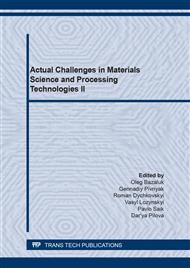p.147
p.157
p.179
p.186
p.194
p.203
p.212
p.226
p.231
Energy and Resources Recovery from Gasified Screenings and Toxic Sludge
Abstract:
Sludge and screenings management is increasingly becoming a dilemma due its accumulating and tightening environmental regulations that limit its disposal methods. Various sludge management options have been researched, ranging from incineration, thermochemical liquefaction, to pyrolysis and gasification. This work proposes syngas, bio-oil, chemical resources and bio-char production for beneficiation through gasification of a mixture of sludge and screenings at different ratios of 25/75, 50/50 and 75/25. It also studies mass loss and toxins possible destruction by gasification temperatures and reactions. Toxicity and CHNS analysis before and after gasification were aimed at finding sludge energy content, while thermogravimetric analysis (TGA), was to find sampling and stopping temperatures during gasification. The overall best results of high syngas quality (high LHV, H2, CO and CH4 contents) and high quality bio-oil (i.e. cleanest, with high crude oil equivalent bonds such as C1 up to C36 and higher applicable bio-oil resources and chemical species obtained) was achieved by a 75/25 ratio, followed by a 50/50 ratio. The results also showed some possibility of biological and chlorinated hydrocarbon toxins (PCBs and PAHs) break down as well as the reduction of sludge and screenings to about 32% of the initial mass. These results can be further investigated for syngas application in power generation and liquid fuel production. Char toxicity can be analysed for its application in agriculture and for its adsorption properties. Char can be analysed for the presence of metals in it.
Info:
Periodical:
Pages:
194-202
Citation:
Online since:
September 2021
Authors:
Keywords:
Price:
Сopyright:
© 2021 Trans Tech Publications Ltd. All Rights Reserved
Share:
Citation:


